Inclination Trend of the Agulhas Return Current Path in Three Decades
Abstract
:1. Introduction
2. Materials and Methods
2.1. Altimetry ADT Data
2.2. Reanalysis Data
- (1)
- ERA5 reanalysis wind dataset
- (2)
- HYCOM reanalysis data
2.3. Definition of the ARC Jet Axis
2.4. EKE
2.5. Definition of the STF and SAF Positions
3. Results
3.1. Variability and Mechanisms of the ARC Path Movement
3.2. Connection between the ARC Path Movement and EKE Variability
3.3. Connection between the Headstream EKE and ARC Topographical Meandering
4. Discussion
5. Conclusions
Author Contributions
Funding
Data Availability Statement
Acknowledgments
Conflicts of Interest
References
- Rouault, M.; Penven, P.; Pohl, B. Warming in the Agulhas Current system since the 1980’s. Geophys. Res. Lett. 2009, 36, L12602. [Google Scholar] [CrossRef]
- Renault, L.; McWilliams, J.C.; Penven, P. Modulation of the Agulhas Current Retroflection and leakage by oceanic current interaction with the atmosphere in coupled simulations. J. Phys. Oceanogr. 2017, 47, 2077–2100. [Google Scholar] [CrossRef]
- Wang, J.; Mazloff, M.R.; Gille, S.T. Pathways of the Agulhas waters poleward of 29°S. J. Geophys. Res.-Ocean. 2014, 119, 4234–4250. [Google Scholar] [CrossRef]
- Rusciano, E.; Speich, S.; Ollitrault, M. Interocean exchanges and the spreading of Antarctic Intermediate Water south of Africa. J. Geophys. Res. Ocean. 2012, 117, C10010. [Google Scholar] [CrossRef]
- Lutjeharms, J.R.E. The Exchange of Water Between the South Indian and South Atlantic Oceans. In The South Atlantic: Present and Past Circulation; Springer: Berlin/Heidelberg, Germany, 1996; pp. 125–162. [Google Scholar]
- Wei, L.; Wang, C. Characteristics of ocean mesoscale eddies in the Agulhas and Tasman Leakage regions from two eddy datasets. Deep. Sea Res. Part II Top. Stud. Oceanogr. 2023, 208, 105264. [Google Scholar] [CrossRef]
- Lutjeharms, J.R.E. The Agulhas Current; Springer: Berlin/Heidelberg, Germany, 2006. [Google Scholar]
- Lutjeharms, J.R.E.; Van Ballegooyen, R.C. Topographic Control in the Agulhas Current System. Deep. Sea Res. Part A Oceanogr. Res. Pap. 1984, 31, 1321–1337. [Google Scholar] [CrossRef]
- Biastoch, A.; Boning, C.W.; Schwarzkopf, F.U.; Lutjeharms, J.R. Increase in Agulhas leakage due to poleward shift of Southern Hemisphere westerlies. Nature 2009, 462, 495–498. [Google Scholar] [CrossRef] [PubMed]
- Van Sebille, E.; Barron, C.N.; Biastoch, A.; van Leeuwen, P.J.; Vossepoel, F.C.; de Ruijter, W.P.M. Relating Agulhas leakage to the Agulhas Current retroflection location. Ocean. Sci. 2009, 5, 511–521. [Google Scholar] [CrossRef]
- Durgadoo, J.V.; Loveday, B.R.; Reason, C.J.C.; Penven, P.; Biastoch, A. Agulhas Leakage Predominantly Responds to the Southern Hemisphere Westerlies. J. Phys. Oceanogr. 2013, 43, 2113–2131. [Google Scholar] [CrossRef]
- Loveday, B.R.; Durgadoo, J.V.; Reason, C.J.C.; Biastoch, A.; Penven, P. Decoupling of the Agulhas Leakage from the Agulhas Current. J. Phys. Oceanogr. 2014, 44, 1776–1797. [Google Scholar] [CrossRef]
- Beal, L.M.; de Ruijter, W.P.; Biastoch, A.; Zahn, R.; Group, S.W.I.W. On the role of the Agulhas system in ocean circulation and climate. Nature 2011, 472, 429–436. [Google Scholar] [CrossRef] [PubMed]
- Drijfhout, S.S.; Blaker, A.T.; Josey, S.A.; Nurser, A.J.G.; Sinha, B.; Balmaseda, M.A. Surface warming hiatus caused by increased heat uptake across multiple ocean basins. Geophys. Res. Lett. 2014, 41, 7868–7874. [Google Scholar] [CrossRef]
- de Ruijter, W.P.M.; Aken, H.M.V.; Beier, E.J.; Lutjeharms, J.R.E.; Matano, R.P.; Schouten, M.W. Eddies and dipoles around South Madagascar: Formation, pathways and large-scale impact. Deep. Sea Res. Part I Oceanogr. Res. Pap. 2004, 51, 383–400. [Google Scholar] [CrossRef]
- Dencausse, G.; Arhan, M.; Speich, S. Spatio-temporal characteristics of the Agulhas Current retroflection. Deep. Sea Res. Part I Oceanogr. Res. Pap. 2010, 57, 1392–1405. [Google Scholar] [CrossRef]
- Van Sebille, E.; Biastoch, A.; van Leeuwen, P.J.; de Ruijter, W.P.M. A weaker Agulhas Current leads to more Agulhas leakage. Geophys. Res. Lett. 2009, 36, L03601. [Google Scholar] [CrossRef]
- Siedler, G.; Rouault, M.; Biastoch, A.; Backeberg, B.; Reason, C.J.C.; Lutjeharms, J.R.E. Modes of the southern extension of the East Madagascar Current. J. Geophys. Res. Ocean. 2009, 114, C01005. [Google Scholar] [CrossRef]
- Zhu, Y.; Li, Y.; Zhang, Z.; Qiu, B.; Wang, F. The observed Agulhas Retroflection behaviors during 1993–2018. J. Geophys. Res. Ocean. 2021, 126, e2021JC017995. [Google Scholar] [CrossRef]
- Backeberg, B.C.; Penven, P.; Rouault, M. Impact of intensified Indian Ocean winds on mesoscale variability in the Agulhas system. Nat. Clim. Chang. 2012, 2, 608–612. [Google Scholar] [CrossRef]
- Lutjeharms, J.R.E.; Van Ballegooyen, R.C. The Retroflection of the Agulhas Current. J. Phys. Oceanogr. 1988, 18, 1570–1583. [Google Scholar] [CrossRef]
- Le Bars, D.; Ruijter, W.P.M.; Dijkstra, H. A New Regime of the Agulhas Current Retroflection: Turbulent Choking of Indian–Atlantic leakage. J. Phys. Oceanogr. 2012, 42, 1158–1172. [Google Scholar] [CrossRef]
- Sallee, J.B.; Speer, K.; Morrow, R. Response of the Antarctic Circumpolar Current to atmospheric variability. J. Clim. 2008, 21, 3020–3039. [Google Scholar] [CrossRef]
- Domingues, R.; Goni, G.; Swart, S.; Dong, S.F. Wind forced variability of the Antarctic Circumpolar Current south of Africa between 1993 and 2010. J. Geophys. Res. Ocean. 2014, 119, 1123–1145. [Google Scholar] [CrossRef]
- Yang, H.; Lohmann, G.; Wei, W.; Dima, M.; Ionita, M.; Liu, J. Intensification and poleward shift of subtropical western boundary currents in a warming climate. J. Geophys. Res. Ocean. 2016, 121, 4928–4945. [Google Scholar] [CrossRef]
- Yang, H.; Lohmann, G.; Krebs-Kanzow, U.; Ionita, M.; Shi, X.X.; Sidorenko, D.; Gong, X.; Chen, X.E.; Gowan, E.J. Poleward Shift of the Major Ocean Gyres Detected in a Warming Climate. Geophys. Res. Lett. 2020, 47, e2019GL085868. [Google Scholar] [CrossRef]
- Qiu, B.; Chen, S.M.; Schneider, N.; Oka, E.; Sugimoto, S. On the Reset of the Wind-Forced Decadal Kuroshio Extension Variability in Late 2017. J. Clim. 2020, 33, 10813–10828. [Google Scholar] [CrossRef]
- Fadida, Y.; Malan, N.; Cronin, M.F.; Hermes, J. Trends in the Agulhas Return Current. Deep. Sea Res. Part I Oceanogr. Res. Pap. 2021, 175, 103573. [Google Scholar] [CrossRef]
- Rio, M.H.; Santoleri, R. Improved global surface currents from the merging of altimetry and Sea Surface Temperature data. Remote Sens. Environ. 2018, 216, 770–785. [Google Scholar] [CrossRef]
- Mulet, S.; Rio, M.H.; Etienne, H.; Artana, C.; Cancet, M.; Dibarboure, G.; Feng, H.; Husson, R.; Picot, N.; Provost, C.; et al. The new CNES-CLS18 global mean dynamic topography. Ocean Sci. 2021, 17, 789–808. [Google Scholar] [CrossRef]
- Hersbach, H.; Bell, B.; Berrisford, P.; Hirahara, S.; Horányi, A.; Muñoz-Sabater, J.; Nicolas, J.; Peubey, C.; Radu, R.; Schepers, D.; et al. The ERA5 global reanalysis. Q. J. R. Meteorol. Soc. 2020, 146, 1999–2049. [Google Scholar] [CrossRef]
- Cummings, J.A. Operational multivariate ocean data assimilation. Q. J. R. Meteorol. Soc. 2005, 131, 3583–3604. [Google Scholar] [CrossRef]
- Cummings, J.A.; Smedstad, O.M. Variational Data Assimilation for the Global Ocean. In Data Assimilation for Atmospheric, Oceanic and Hydrologic Applications; Springer: Berlin/Heidelberg, Germany, 2013; Volume II, Chapter 13; pp. 303–343. [Google Scholar]
- Qiu, B.; Chen, S.M. Variability of the Kuroshio Extension jet, recirculation gyre, and mesoscale eddies on decadal time scales. J. Phys. Oceanogr. 2005, 35, 2090–2103. [Google Scholar] [CrossRef]
- Clifford, M.A. A Descriptive Study of the Zonation of the Antarctic Circumpolar Current and Its Relation to Wind Stress and Ice Cover. Ph.D. Thesis, Texas A&M University, College Station, TX, USA, 1983. [Google Scholar]
- Zhu, Y.N.; Qiu, B.; Lin, X.P.; Wang, F. Interannual Eddy Kinetic Energy Modulations in the Agulhas Return Current. J. Geophys. Res.-Oceans 2018, 123, 6449–6462. [Google Scholar] [CrossRef]
- Boebel, O.; Rossby, T.; Lutjeharms, J.; Zenk, W.; Barron, C. Path and variability of the Agulhas Return Current. Deep. Sea Res. Part II Top. Stud. Oceanogr. 2003, 50, 35–56. [Google Scholar] [CrossRef]


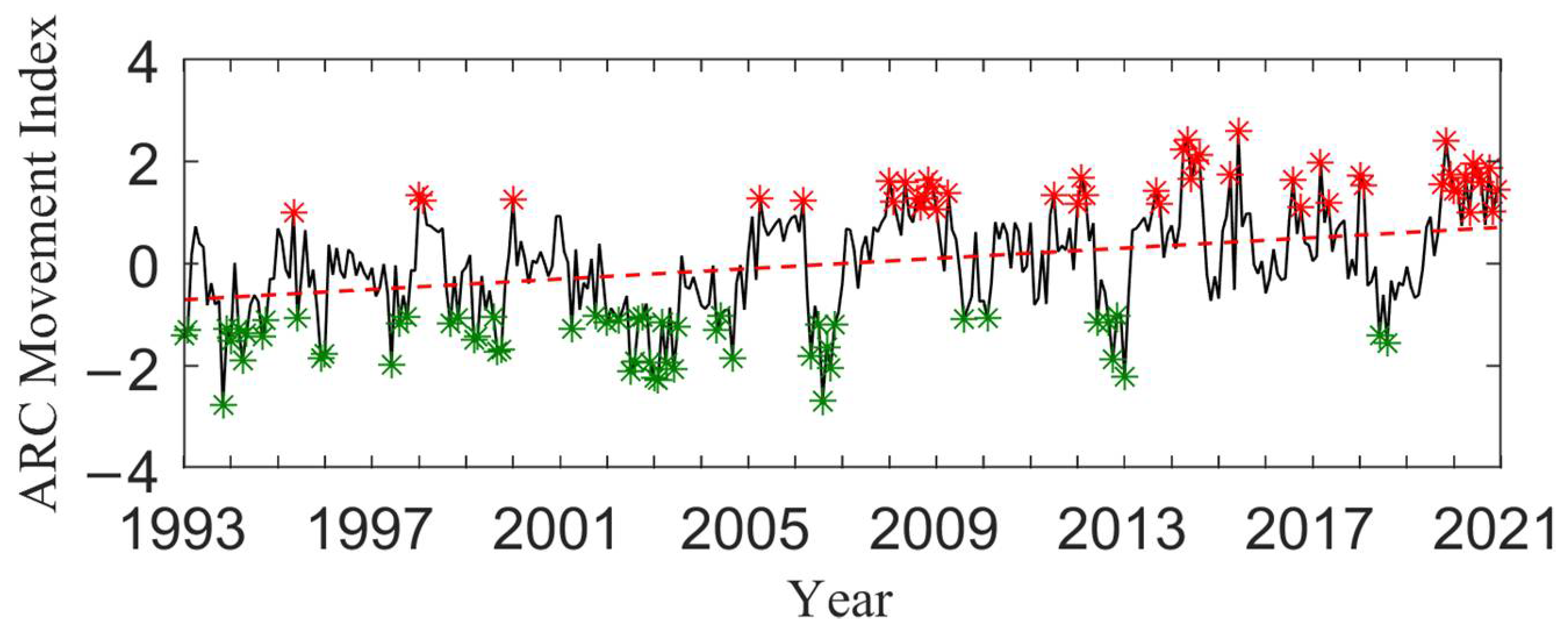
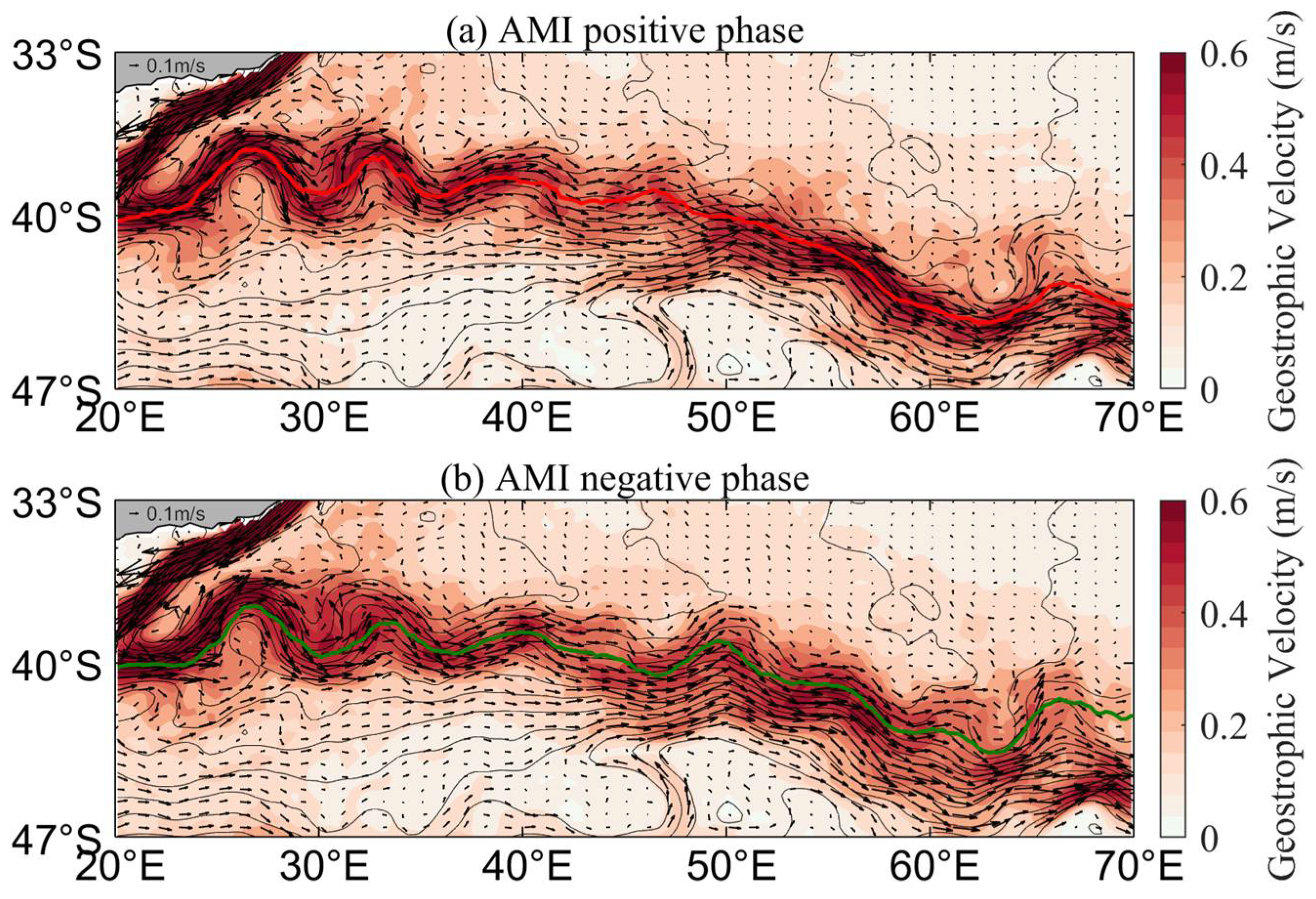
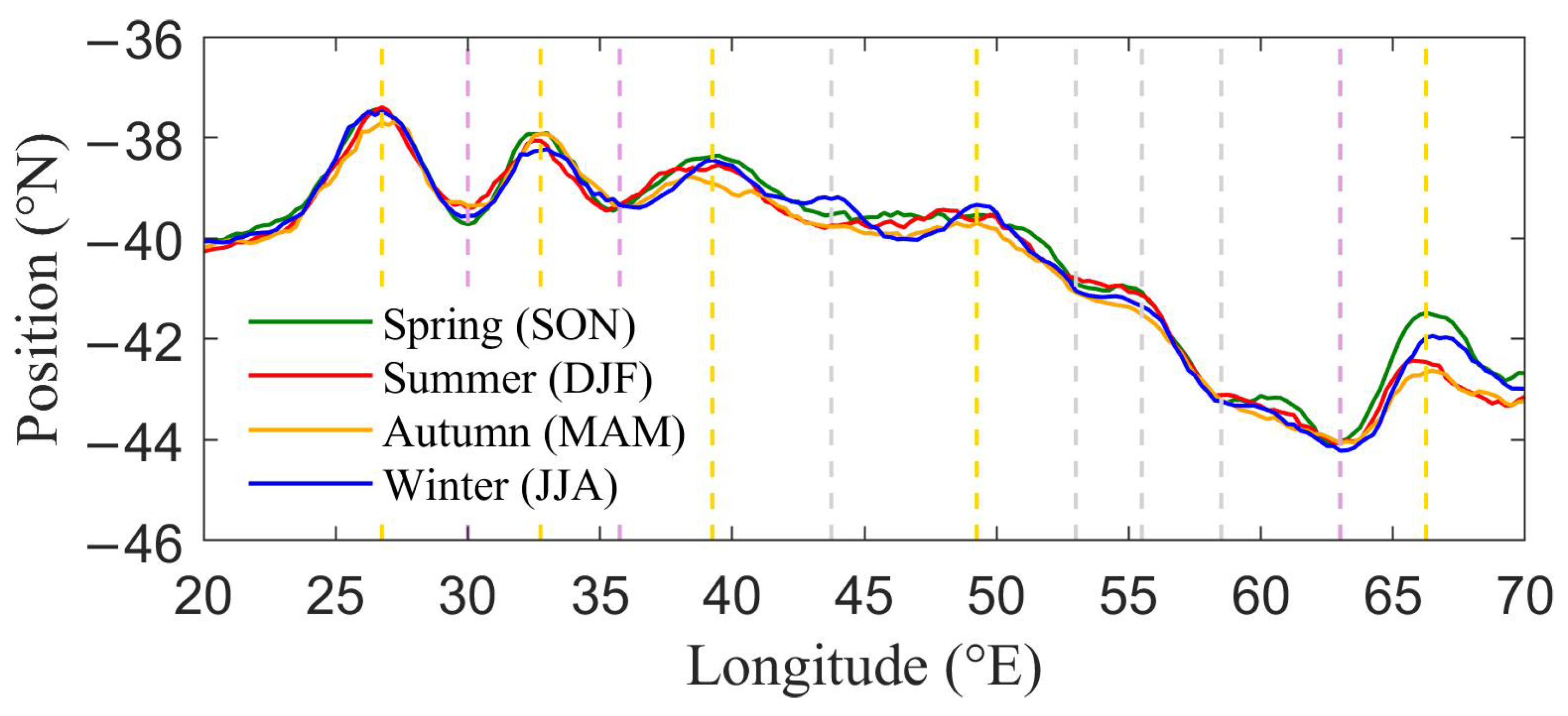


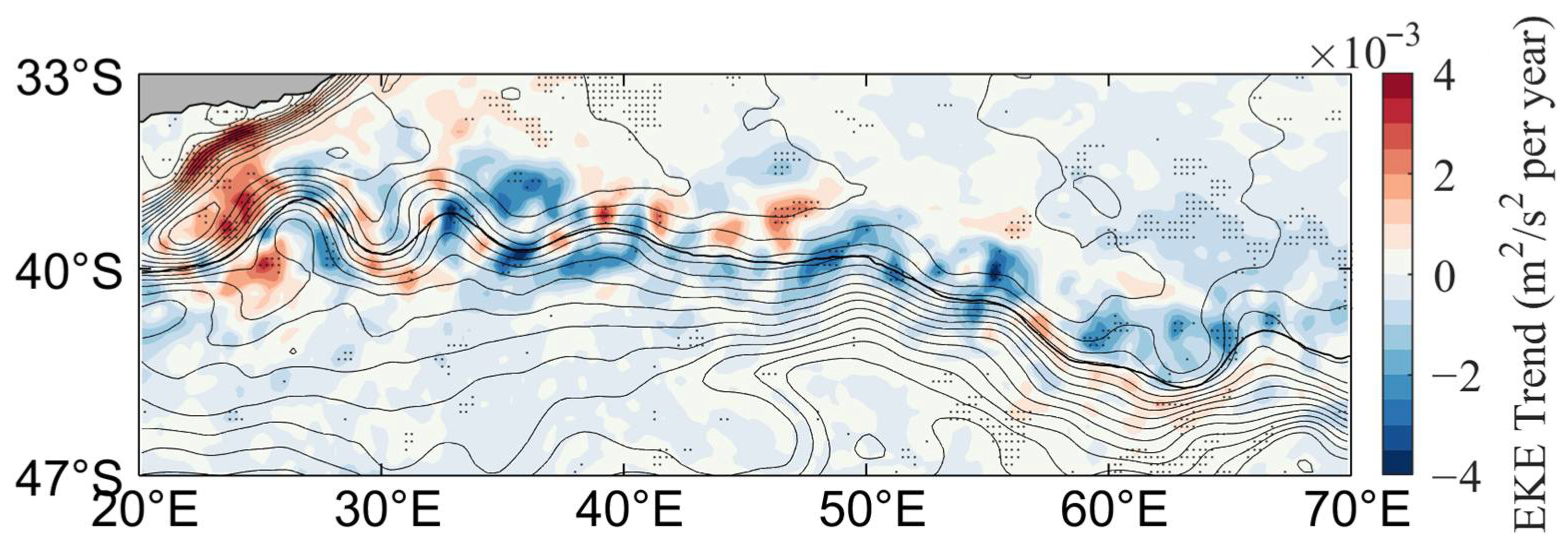
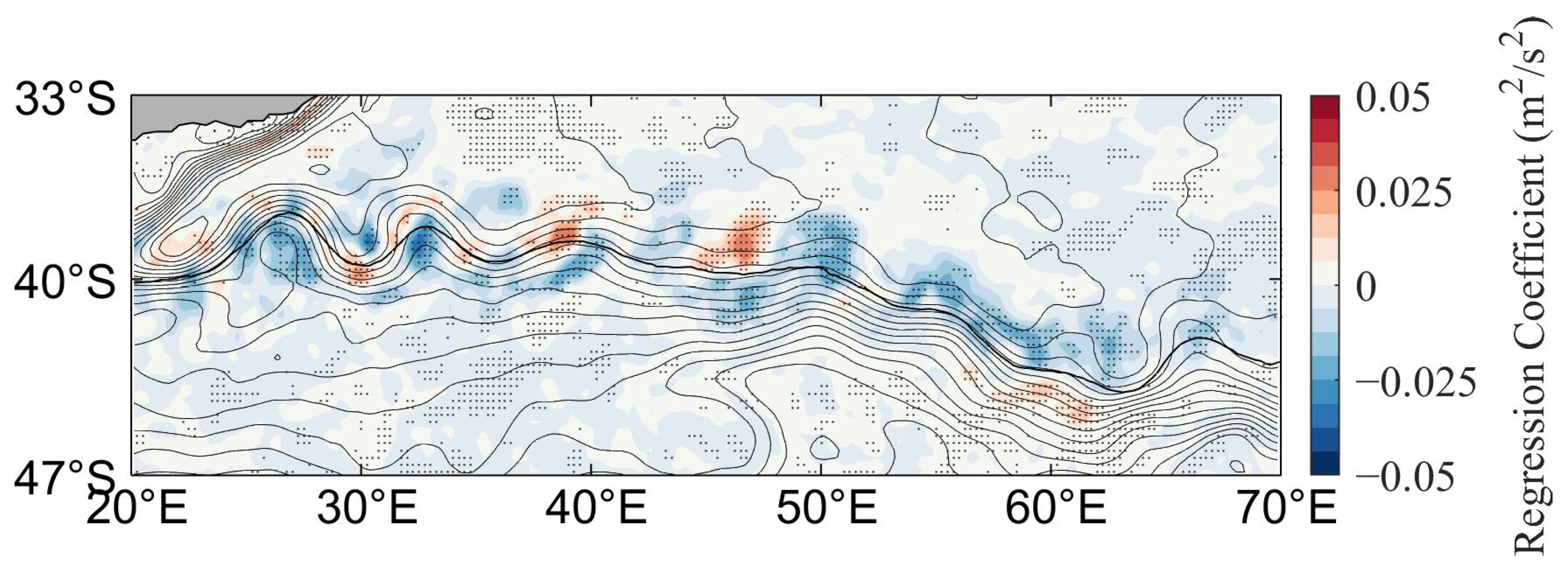
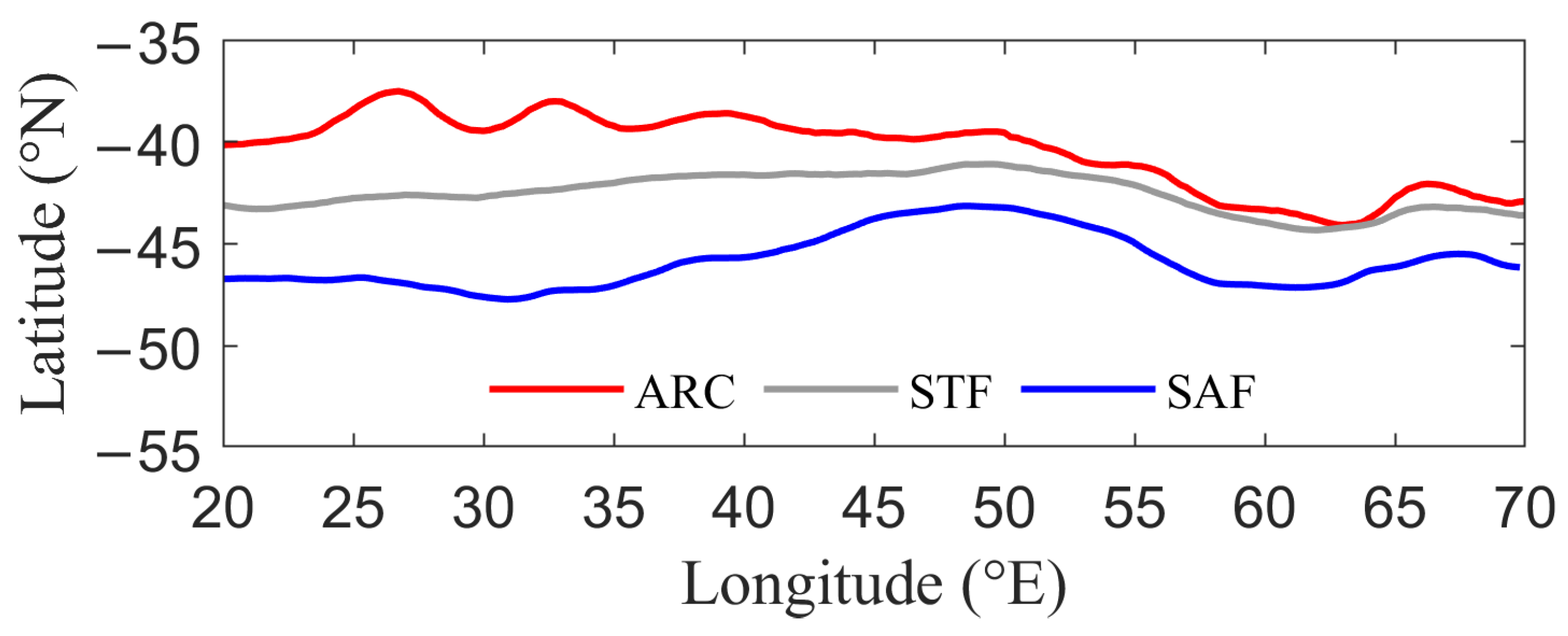
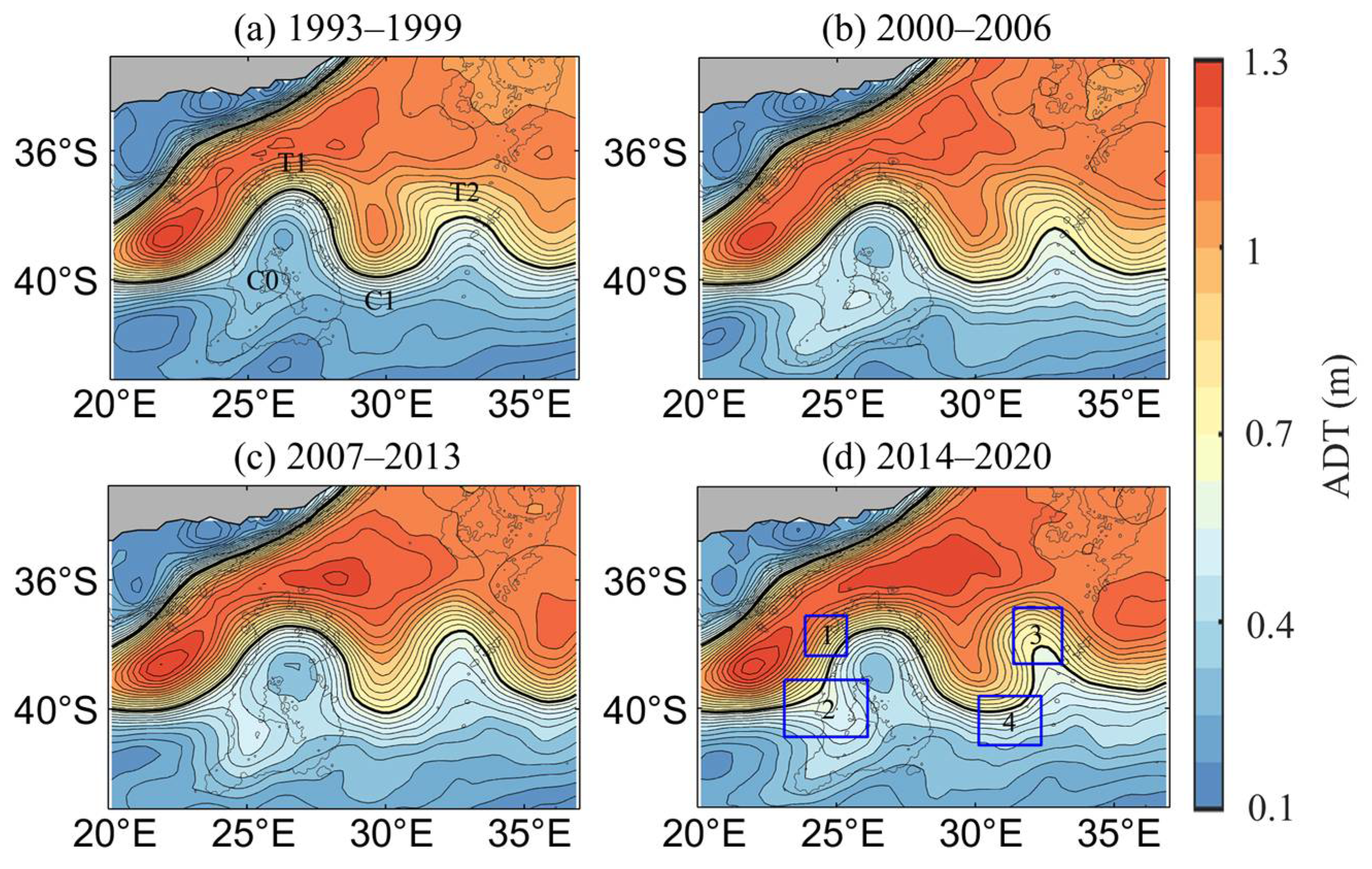
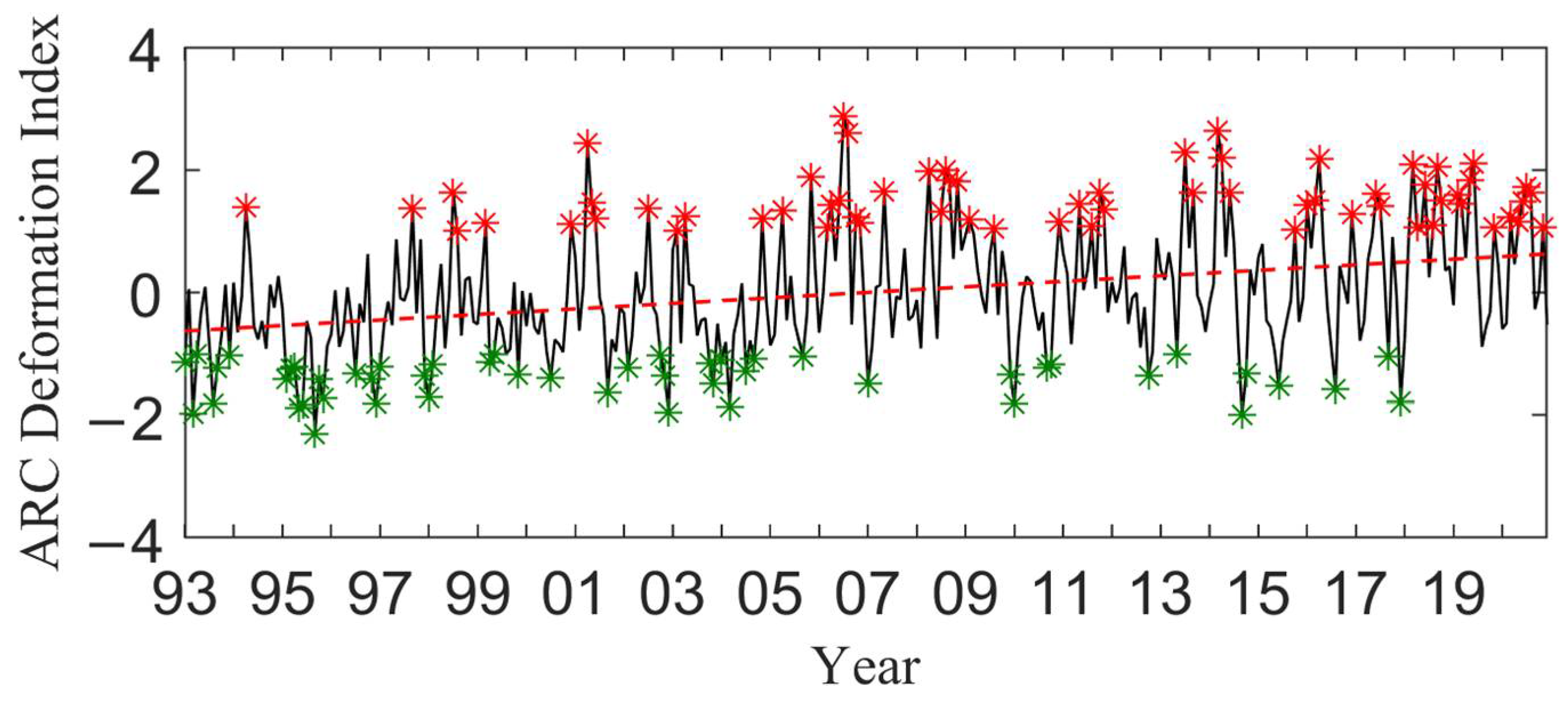

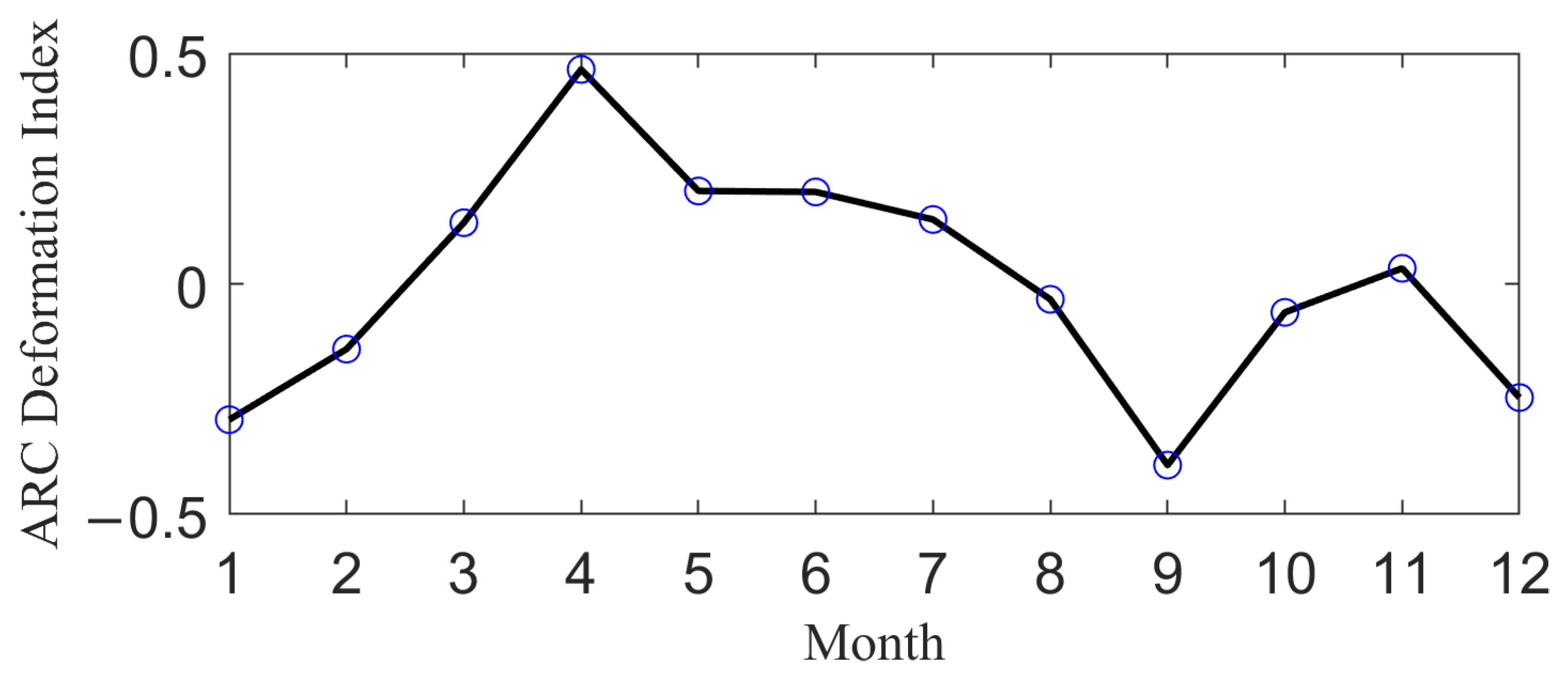
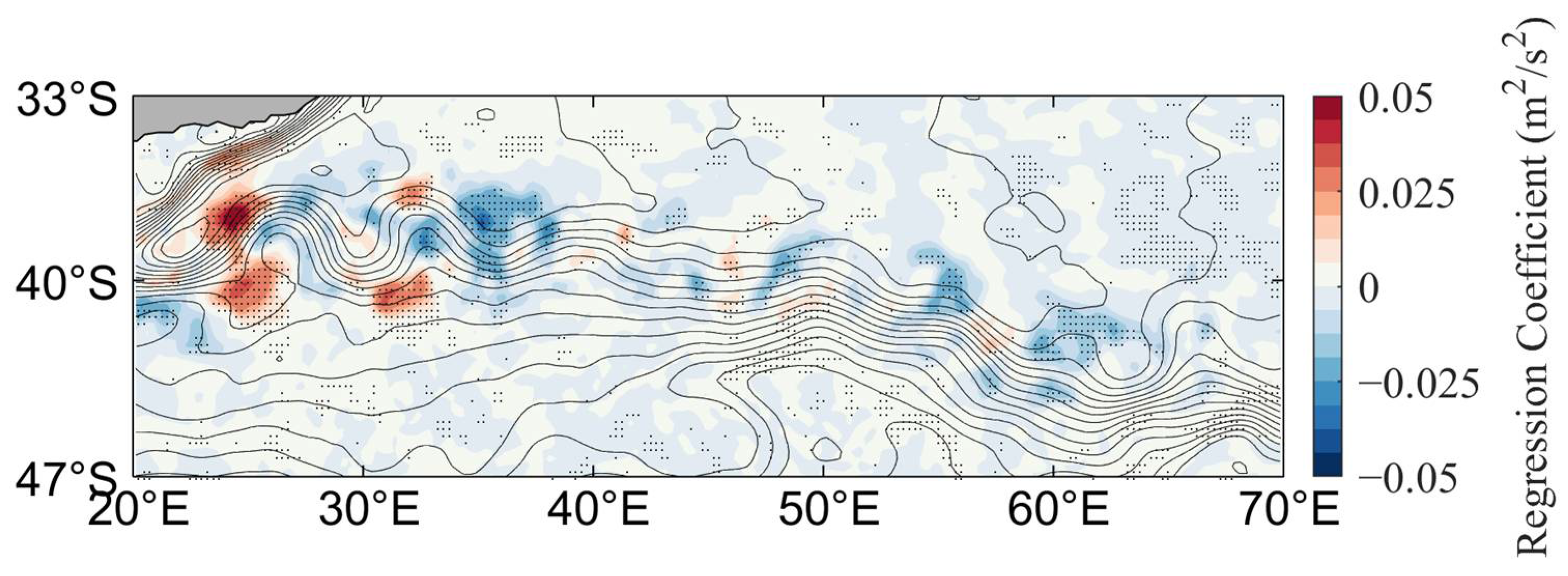
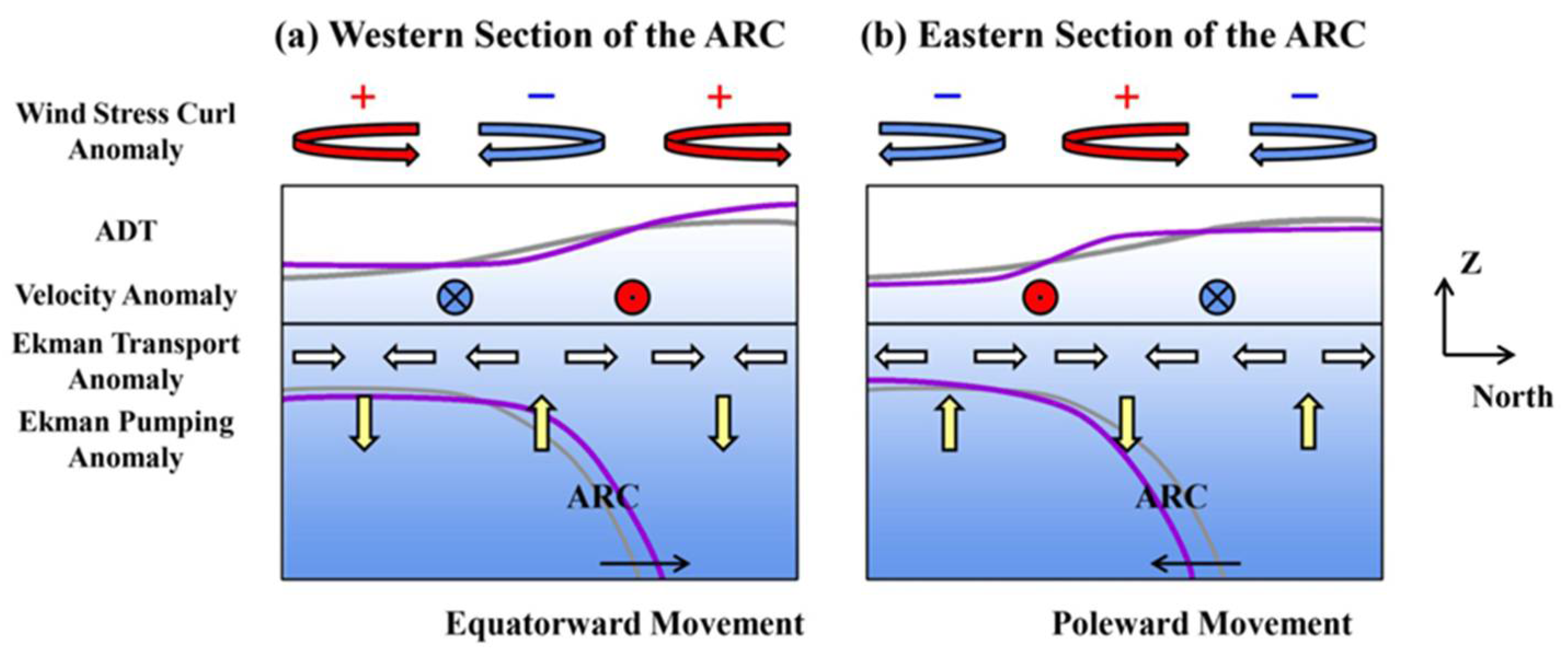
Disclaimer/Publisher’s Note: The statements, opinions and data contained in all publications are solely those of the individual author(s) and contributor(s) and not of MDPI and/or the editor(s). MDPI and/or the editor(s) disclaim responsibility for any injury to people or property resulting from any ideas, methods, instructions or products referred to in the content. |
© 2023 by the authors. Licensee MDPI, Basel, Switzerland. This article is an open access article distributed under the terms and conditions of the Creative Commons Attribution (CC BY) license (https://creativecommons.org/licenses/by/4.0/).
Share and Cite
Lin, Y.; Lin, L.; Wang, D.; Yang, X.-Y. Inclination Trend of the Agulhas Return Current Path in Three Decades. Remote Sens. 2023, 15, 5652. https://doi.org/10.3390/rs15245652
Lin Y, Lin L, Wang D, Yang X-Y. Inclination Trend of the Agulhas Return Current Path in Three Decades. Remote Sensing. 2023; 15(24):5652. https://doi.org/10.3390/rs15245652
Chicago/Turabian StyleLin, Yan, Liru Lin, Dongxiao Wang, and Xiao-Yi Yang. 2023. "Inclination Trend of the Agulhas Return Current Path in Three Decades" Remote Sensing 15, no. 24: 5652. https://doi.org/10.3390/rs15245652





